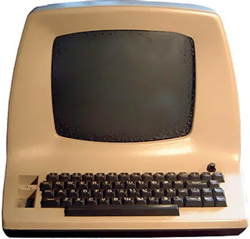Before you can even think about releasing your first quadruple-platinum album, you’ll need some way to record it. For years, big ‘ol tape machines ruled the recording world. I’ve got a buddy who laughs at how much much useless information from “the analog days” is taking up valuable space in his brain – things like like how to align a 2-inch tape machine.
While it used to take up to several hours just to set up the studio for recording (aligning tape machines, zeroing out the console, setting up the patchbay), now I can walk into my studio, flip on a power switch, double click on an icon, and I don’t even have time to make coffee before my studio is ready to start recording the next “Bohemian Rhapsody.”
Thank God for computers. Sure, they bring in an entirely different level of complexity, but they allow the average Joe to spend a few hundred bucks and have (in many ways) the same capabilities as the big analog studios that cost thousands upon thousands of dollars. Having a “home recording studio” simply wasn’t feasible for most people 20 years ago. Now I’m amazed at the music we are able to produce from a bedroom in an apartment.
The other side of that coin, however, is that it becomes just as easy for horrible musicians to record themselves. This is a topic of another discussion for another day. I’m operating under the assumption that you are planning to use your home studio to make good music. Make good music.
So what computer should you get? The majority of the time, your home computer will have plenty of power to run most recording programs out there. I’m not going to give an exhaustive list of specs and requirements, because that changes every few months.
For the purpose of this article, suffice it to say that you should consult the manufacturers’ websites. They all have a “minimum requirements” page that should be helpful, especially if you’re going to buy a new computer. Please, please, PLEASE do yourself a favor and research software requirements before buying your computer. You’ll be glad you did.
That being said, one HUGE thing you can do to beef up your current (or brand new) computer is add more RAM. RAM is where the magic happens. That’s where all your audio will be processed, so the more the merrier.
Mac or PC?
Ah, the age-old question. All the Mac guys are touting the superiority of their machines. All the PC guys are trying to prove that theirs are just as cool. I’m a Mac guy myself, but I’m not so naive as to think that owning a Mac is the only way you can possibly produce anything creative.
What I will say is this. One reason Apple computers tend to get the reputation of being more “stable” is because they’re all the same.
Think about it, how many stores do you know of that build Apple computers? None. They’re all built by Apple. They all have the same components. PCs, on the other hand, can be built by just about anyone. You could order the same computer (same processor speed, same amount of RAM) from Dell, Gateway, HP, and Walmart, and each one would be completely different from the next, even though they all have similar specs.





















